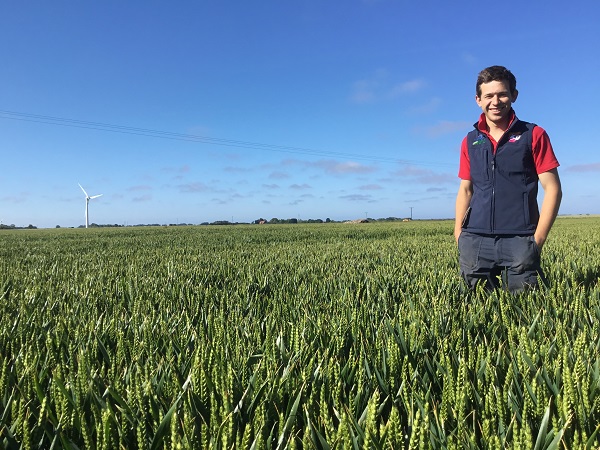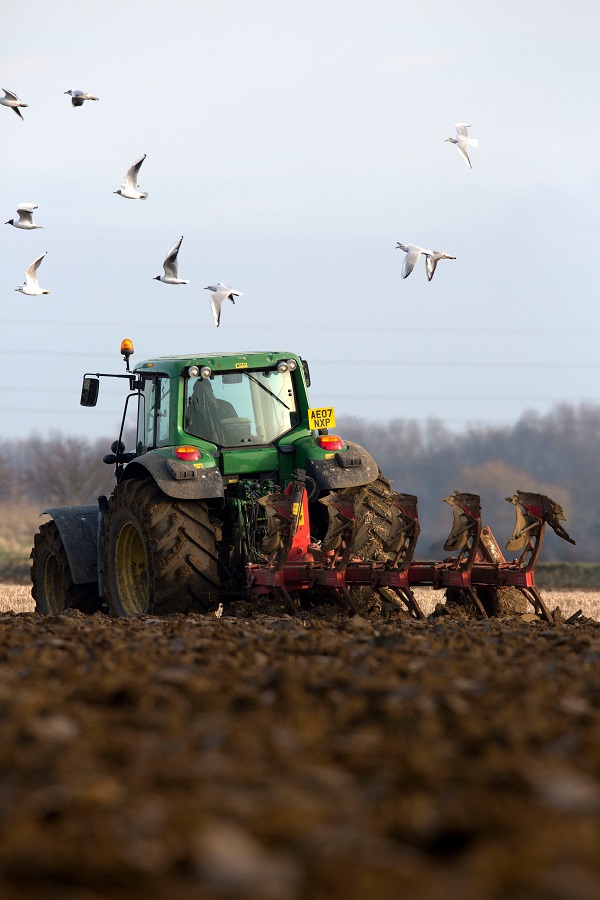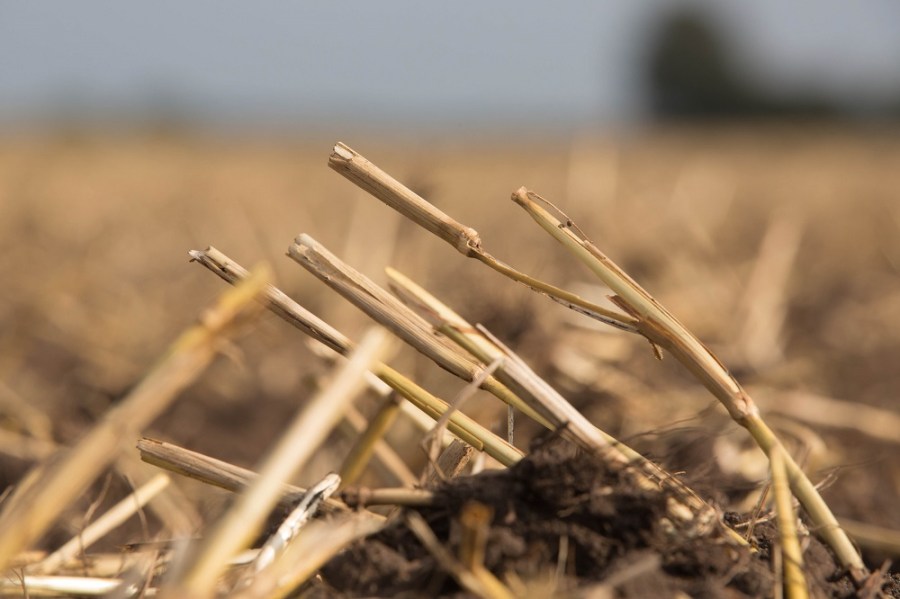In the battle against difficult grassweeds, some farmers are turning back to the plough to seize control, while others are cutting out cultivation altogether. CPM spoke to two farmers using opposing systems to understand how they are controlling blackgrass.
The most profitable farming and wheat yields still comes from ploughing.
By Lucy de la Pasture and Rob Jones
Five years ago, Matthew Denby was losing large areas of crop due to the high levels of blackgrass. But with the use of continuous ploughing, he says weed levels are fast diminishing. Matthew farms 720ha of winter cereals and oilseed rape near Alford, Lincs alongside his brother, father and grandfather.

Matthew Denby is getting a reduction in blackgrass by ploughing for cereals, two in every three years, and using a Simba SL with low disturbance legs for drilling OSR.
“We’ve trialled different methods of control on the farm including min-till, cover crops and spring cropping but they led to very poor blackgrass control. One particular area of spring barley had to be entirely sprayed off because the grassweed levels were far worse than the rest of the field which was ploughed.
“After ploughing for cereals two in every three years and using our Simba SL with low disturbance legs for drilling OSR, we have since seen a significant reduction in blackgrass. We get very good levels of control using OSR as a cleaning crop by using glyphosate pre-drilling, followed by clethodim and propyzamide.”
Within five years, the farm has gone from red-mapped fields having thousands of blackgrass heads/m2, to now being in a position to hand rogue any remaining heads.
“Blackgrass is now at low levels with no need to spray anything off. The key for us has been ploughing early because it enables us to get a really good seedbed. Ploughing in late July/early August following OSR enables our soils to withstand plenty of rain and produces an excellent seedbed. The soil is mellowed and conditioned by the wetting and drying process from rainfall in late summer.
“There seems to be a couple of key reasons why drilling later has benefited the farm. It’s a fact that less blackgrass germinates the later a crop is sown and there is more time to create a stale seedbed using glyphosate. Added to that, the soil is more likely to be moist, producing better efficacy from the residual herbicides.”

Rotational ploughing is still one of the key elements in integrated blackgrass control but is only effective if good inversion is achieved.
Cereal drilling commences on 1 Oct on the farm’s historically cleaner land and after 10 Oct on dirtier land with a blackgrass history. All winter cereals receive tri-allate granules applied pre-emergence as well as a liquid stack of residuals split across pre-em and early post-emergence.
With a mix of medium marsh land and heavy clay soils, Matthew says their options are limited and contending with the weather and late drilling on a min-till system poses too much risk.
“Spring crops tend to be unreliable too on the heavier land and we end up with wet soils after spring barley because it doesn’t draw up as much moisture as a winter crop.
“On clay soils like ours you need as many tools in your shed as possible and the plough is very valuable. We’re very open to ideas and different systems, but we’ve tried various methods and the best results for blackgrass control and most importantly, the most profitable farming and wheat yields still comes from ploughing. Our soil health is as good as any comparable soil type and with the government thinking about going in the direction of no-till, they need to be a made aware that sadly this isn’t a system that works for everyone.”
But for Kent farmer Tom Sewell, who grows 450ha of cereals, OSR and beans near Maidstone, repeatedly reworking the soil seemed a counterproductive approach.
After dedicating three years to researching no-till, completing a Nuffield Scholarship along the way, Tom took the plunge and went 100% no-till in one season. Since then, he maintains that the benefits have been endless.
“The true motivation for us in adopting no-till has always been soil health. We have very abrasive soils here and are used to wearing metal out very fast. When we used to plough we’d be replacing plough points every lunchtime.”
Although grassweeds are still an issue on parts of the farm, Tom is unconvinced that ploughing could solve this, with the most vital tool in his box being glyphosate. “Because we’re not cultivating, when the seed hits the floor it stays there covered in straw and germinates consistently at the same time.”
This means any emerging blackgrass plants can be sprayed prior to drilling, targeting the majority of the problem before it can become established.
“As a result of our low soil disturbance, blackgrass is very shallow rooted and we’re also finding our Liberator (flufenacet+ diflufenican) and Atlantis (mesosulfuron+ iodosulfuron) are working better than ever before. The improved soil structure and shallow rooting means we’re targeting much smaller plants.
“During cultivation blackgrass seeds can be spread 7-10cm deep and spread throughout the soil profile and you can’t tell when they’ll germinate. They also become much deeper rooted and established. Our blackgrass control is not 100% but I don’t think ploughing or cultivation would solve the problem. Blackgrass typically grows in unhealthy, poorly drained soils so I hope over time populations will naturally diminish.”
Independent weed scientist Dr Stephen Moss explains why although rotational ploughing is valuable, no-till conditions also have potential to implement some blackgrass control.
“Historical research shows quite conclusively that blackgrass is encouraged by reduced tillage because you’re keeping seeds near to the soil surface from where seedlings can readily emerge. But there’s no denying that low disturbance techniques can be effective in getting on top of blackgrass, and this may be down to the increased efficacy of pre-ems because seeds are kept near the surface where the herbicide can make best contact.
“If this is the case, it may explain why some people have got on so well with very shallow tillage, especially when combined with other changes such as delayed autumn sowing or spring cropping. However, if prevention of blackgrass seed return cannot be maintained, shallow tillage is a recipe for a very rapid population increase.”
Rotational ploughing is still one of the key elements in the integrated control of blackgrass according to Stephen, but he also believes there’s a reason many farmers may not be seeing the best results.
“Rotational ploughing is only really effective if you get a good inversion. A lot of farmers are failing to achieve the benefits because they’re ploughing in unsuitable conditions, going too fast or perhaps using the wrong type of plough,” he says.
“The benefits of ploughing are very dependent on how many seeds you are burying compared to how many you are bringing up. This is why rotational ploughing still has a very useful role when used every four or five years, because not many blackgrass seeds will survive that long in the soil.
“If you’re ploughing continuously it will tend to stop blackgrass suddenly building up very rapidly, but you could argue that if you’re trying to eradicate blackgrass, ploughing could make the problem persist for longer.”
There’s no simple ‘ideal’ cultivation strategy for blackgrass because the best approach depends on the individual farm, soil types and crops grown, he says.
“The key to long-term blackgrass control is to show commitment to the ‘5 for 5’ strategy which involves five key elements: stopping blackgrass seeding, appropriate cultivations, later sowing dates, greater crop competition and an effective herbicide programme.
“Farmers need to plan a strategy at the individual field level for the next five years to make real inroads. You can’t expect to get on top of things in just one or two years because 25% of blackgrass seeds survive from one year to the next. But over five years substantial reductions are possible.
“This year people saw good control from pre-ems which could lull farmers into a false sense of security thinking their blackgrass problem has ‘gone away’. But start to drill early again or cut back on post-ems and it will be back with a vengeance, especially if autumn conditions are less favourable for pre-em herbicides.”
Balancing autumn grassweed and volunteer OSR control
Where blackgrass is a problem on the farm most management decisions revolve around the grassweed as other potential problems pale into insignificance. But this doesn’t need to be the case, believes weed management specialist Barrie Hunt, who runs the Roundup technical support service.
He has no doubt that autumn is the best time to deal with both grassweeds and OSR volunteers. And he has a proven way of overcoming their conflicting management needs based on the best understanding of OSR and grassweed biology.
Cultivation immediately after harvesting has become standard practice for growers wanting the best control of problem grassweeds ahead of winter cereal drilling. But it’s about the worst thing they can do after oilseed rape if they also want to deal with the volunteers that can be so problematic in arable rotations, he says.
“Volunteers are inevitable consequence of OSR growing. A small amount of seed loss is unavoidable even with the best pod shatter resistant varieties, combining technologies and harvesting practice.
“This wouldn’t be a problem but for two things. First, every 10 kg/ha lost is typically more than one and a half million seeds (or around 170 seeds/m2). And second, a proportion of these can remain viable in the soil for a good 10 years,” he says.
“So, as well as getting in the way of your first wheat and providing an ideal environment for slugs, volunteers can seriously interfere with the management and productivity of your future OSR crops. They’re also a prime culprit in the erucic acid contamination of ‘double lows’ on land once used for HEAR growing,” comments Barrie.
“On the plus side, we’re dealing with seeds specifically bred to germinate readily and reliably when at or very near the soil surface. Often – as autocasters will testify – a combination of chaff and dew are sufficient. This means we can stimulate the vast majority of shed OSR seed to grow by not burying it to anything more than a couple of centimetres. Cultivating it down any deeper will only encourage dormancy and future trouble,” he says.
Not cultivating stubbles immediately following OSR harvesting appears to fly in the face of the best grassweed management practice. But Barrie stresses that it needn’t do so if growers follow a simple ‘twin-track’ approach.
Having left OSR stubbles uncultivated for up to four weeks then spraying-off the volunteers and any very low dormancy blackgrass, he recommends light tillage and consolidation to minimise moisture loss and set up a stale seedbed. This will bring on the bulk of the grassweeds for spraying off just ahead of drilling.
“If you have bad blackgrass, ryegrass or brome you shouldn’t be drilling wheat until mid-Oct at the earliest. So with OSR coming off before the end of July, you have plenty of time for this approach. The beauty of this is it enables you to deal with both volunteers and grassweeds in the best possible way, without compromise,” he explains.
“On the one hand, you leave any shed seed open to predation by birds and mammals and get the maximum flush of small, poorly rooted volunteers which are especially vulnerable to glyphosate. And on the other hand, you achieve the surface cover needed for the maximum flush of blackgrass, ryegrass and sterile brome for control ahead of your wheat drilling.
“This twin track approach also helps you get rid of any soft, meadow and rye brome seed which needs surface after-ripening before burial to stimulate germination, together with perennial weeds which are best left to grow out of the stubble before spraying.
Cultivation between glyphosate sprays is important to minimise the risk of resistance development, adds Barrie, along with using sufficient rates of the most active glyphosate formulations and the best application practice.
“With such unreliable post-emergence herbicide performance these days, the most effective autumn treatment is critical in managing difficult grassweeds. This makes it vital your pre-planting sprays work as hard as they can in every way.”




